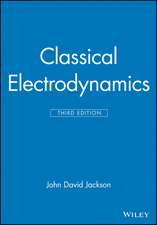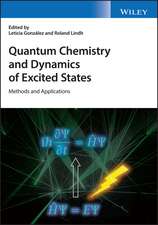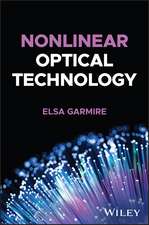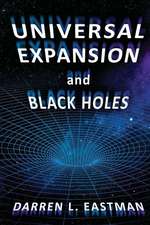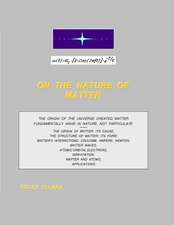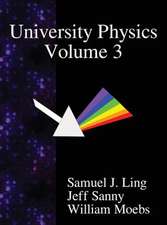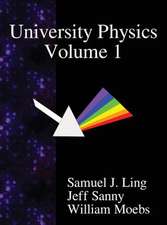Introduction to Computational Chemistry, 3e
Autor F. Jensenen Limba Engleză Paperback – 2 feb 2017
∗ Polarizable force fields
∗ Tight–binding DFT
∗ More extensive DFT functionals, excited states and time dependent molecular properties
∗ Accelerated Molecular Dynamics methods
∗ Tensor decomposition methods
∗ Cluster analysis
∗ Reduced scaling and reduced prefactor methods
Additional information is available at:www.wiley.com/go/jensen/computationalchemistry3
Preț: 498.72 lei
Preț vechi: 623.40 lei
-20% Nou
95.43€ • 99.64$ • 78.98£
Carte disponibilă
Livrare economică 15-29 martie
Livrare express 01-07 martie pentru 53.23 lei
Specificații
ISBN-10: 1118825993
Pagini: 660
Dimensiuni: 191 x 245 x 28 mm
Greutate: 1.11 kg
Ediția:3rd Edition
Editura: Wiley
Locul publicării:Chichester, United Kingdom
Public țintă
Primary: Textbook for advanced undergraduate and graduate courses in computational chemistrySecondary: Professional researchers/experimentalists using computational methods as a tool for aiding interpretations and designing new experiments and compounds.
Cuprins
Preface to the First Edition xv
Preface to the Second Edition xix
Preface to the Third Edition xxi
1 Introduction 1
1.1 Fundamental Issues 2
1.2 Describing the System 3
1.3 Fundamental Forces 3
1.4 The Dynamical Equation 5
1.5 Solving the Dynamical Equation 7
1.6 Separation of Variables 8
1.7 Classical Mechanics 11
1.8 Quantum Mechanics 13
1.9 Chemistry 18
References 19
2 Force Field Methods 20
2.1 Introduction 20
2.2 The Force Field Energy 21
2.3 Force Field Parameterization 53
2.4 Differences in Atomistic Force Fields 62
2.5 Water Models 66
2.6 Coarse Grained Force Fields 67
2.7 Computational Considerations 69
2.8 Validation of Force Fields 71
2.9 Practical Considerations 73
2.10 Advantages and Limitations of Force Field Methods 73
2.11 Transition Structure Modeling 74
2.12 Hybrid Force Field Electronic Structure Methods 78
References 82
3 Hartree–Fock Theory 88
3.1 The Adiabatic and Born–Oppenheimer Approximations 90
3.2 Hartree–FockTheory 94
3.3 The Energy of a Slater Determinant 95
3.4 Koopmans’ Theorem 100
3.5 The Basis Set Approximation 101
3.6 An Alternative Formulation of the Variational Problem 105
3.7 Restricted and Unrestricted Hartree–Fock 106
3.8 SCF Techniques 108
3.9 Periodic Systems 119
References 121
4 Electron Correlation Methods 124
4.1 Excited Slater Determinants 125
4.2 Configuration Interaction 128
4.3 Illustrating how CI Accounts for Electron Correlation, and the RHF Dissociation Problem 135
4.4 The UHF Dissociation and the Spin Contamination Problem 138
4.5 Size Consistency and Size Extensivity 142
4.6 Multiconfiguration Self–Consistent Field 143
4.7 Multireference Configuration Interaction 148
4.8 Many–Body Perturbation Theory 148
4.9 Coupled Cluster 157
4.10 Connections between Coupled Cluster, Configuration Interaction and Perturbation Theory 162
4.11 Methods Involving the Interelectronic Distance 166
4.12 Techniques for Improving the Computational Efficiency 169
4.13 Summary of Electron Correlation Methods 174
4.14 Excited States 176
4.15 Quantum Monte Carlo Methods 183
References 185
5 Basis Sets 188
5.1 Slater– and Gaussian–Type Orbitals 189
5.2 Classification of Basis Sets 190
5.3 Construction of Basis Sets 194
5.4 Examples of Standard Basis Sets 200
5.5 Plane Wave Basis Functions 208
5.6 Grid and Wavelet Basis Sets 210
5.7 Fitting Basis Sets 211
5.8 Computational Issues 211
5.9 Basis Set Extrapolation 212
5.10 Composite Extrapolation Procedures 215
5.11 Isogyric and Isodesmic Reactions 222
5.12 Effective Core Potentials 223
5.13 Basis Set Superposition and Incompleteness Errors 226
References 228
6 Density Functional Methods 233
6.1 Orbital–Free Density Functional Theory 234
6.2 Kohn–Sham Theory 235
6.3 Reduced Density Matrix and Density Cumulant Methods 237
6.4 Exchange and Correlation Holes 241
6.5 Exchange–Correlation Functionals 244
6.6 Performance of Density Functional Methods 258
6.7 Computational Considerations 260
6.8 Differences between Density Functional Theory and Hartree–Fock 262
6.9 Time–Dependent Density Functional Theory (TDDFT) 263
6.10 Ensemble Density Functional Theory 268
6.11 Density Functional Theory Problems 269
6.12 Final Considerations 269
References 270
7 Semi–empirical Methods 275
7.1 Neglect of Diatomic Differential Overlap (NDDO) Approximation 276
7.2 Intermediate Neglect of Differential Overlap (INDO) Approximation 277
7.3 Complete Neglect of Differential Overlap (CNDO) Approximation 277
7.4 Parameterization 278
7.5 Hückel Theory 283
7.6 Tight–Binding Density Functional Theory 285
7.7 Performance of Semi–empirical Methods 287
7.8 Advantages and Limitations of Semi–empirical Methods 289
References 290
8 Valence Bond Methods 291
8.1 Classical Valence Bond Theory 292
8.2 Spin–Coupled Valence Bond Theory 293
8.3 Generalized Valence Bond Theory 297
References 298
9 Relativistic Methods 299
9.1 The Dirac Equation 300
9.2 Connections between the Dirac and Schrödinger Equations 302
9.3 Many–Particle Systems 306
9.4 Four–Component Calculations 309
9.5 Two–Component Calculations 310
9.6 Relativistic Effects 313
References 315
10 Wave Function Analysis 317
10.1 Population Analysis Based on Basis Functions 317
10.2 Population Analysis Based on the Electrostatic Potential 320
10.3 Population Analysis Based on the Electron Density 323
10.4 Localized Orbitals 329
10.5 Natural Orbitals 333
10.6 Computational Considerations 337
10.7 Examples 338
References 339
11 Molecular Properties 341
11.1 Examples of Molecular Properties 343
11.2 Perturbation Methods 347
11.3 Derivative Techniques 349
11.4 Response and Propagator Methods 351
11.5 Lagrangian Techniques 351
11.6 Wave Function Response 353
11.7 Electric Field Perturbation 357
11.8 Magnetic Field Perturbation 358
11.9 Geometry Perturbations 367
11.10 Time–Dependent Perturbations 372
11.11 Rotational and Vibrational Corrections 377
11.12 Environmental Effects 378
11.13 Relativistic Corrections 378
References 378
12 Illustrating the Concepts 380
12.1 Geometry Convergence 380
12.2 Total Energy Convergence 383
12.3 Dipole Moment Convergence 385
12.4 Vibrational Frequency Convergence 386
12.5 Bond Dissociation Curves 389
12.6 Angle Bending Curves 394
12.7 Problematic Systems 396
12.8 Relative Energies of C4H6 Isomers 399
References 402
13 Optimization Techniques 404
13.1 Optimizing Quadratic Functions 405
13.2 Optimizing General Functions: Finding Minima 407
13.3 Choice of Coordinates 415
13.4 Optimizing General Functions: Finding Saddle Points (Transition Structures) 418
13.5 Constrained Optimizations 431
13.6 Global Minimizations and Sampling 433
13.7 Molecular Docking 440
13.8 Intrinsic Reaction Coordinate Methods 441
References 444
14 Statistical Mechanics and Transition State Theory 447
14.1 Transition State Theory 447
14.2 Rice–Ramsperger–Kassel–Marcus Theory 450
14.3 Dynamical Effects 451
14.4 StatisticalMechanics 452
14.5 The Ideal Gas, Rigid–Rotor Harmonic–Oscillator Approximation 454
14.6 Condensed Phases 464
References 468
15 Simulation Techniques 469
15.1 Monte Carlo Methods 472
15.2 Time–Dependent Methods 474
15.3 Periodic Boundary Conditions 491
15.4 Extracting Information from Simulations 494
15.5 Free Energy Methods 499
15.6 Solvation Models 502
References 511
16 Qualitative Theories 515
16.1 Frontier Molecular Orbital Theory 515
16.2 Concepts from Density Functional Theory 519
16.3 Qualitative Molecular Orbital Theory 522
16.4 Energy Decomposition Analyses 524
16.5 Orbital Correlation Diagrams: TheWoodward–Hoffmann Rules 526
16.6 The Bell–Evans–Polanyi Principle/Hammond Postulate/Marcus Theory 534
16.7 More O’Ferrall–Jencks Diagrams 538
References 541
17 Mathematical Methods 543
17.1 Numbers, Vectors, Matrices and Tensors 543
17.2 Change of Coordinate System 549
17.3 Coordinates, Functions, Functionals, Operators and Superoperators 560
17.3.1 Differential Operators 562
17.4 Normalization, Orthogonalization and Projection 563
17.5 Differential Equations 565
17.6 Approximating Functions 568
17.7 Fourier and Laplace Transformations 577
17.8 Surfaces 577
References 580
18 Statistics and QSAR 581
18.1 Introduction 581
18.2 Elementary Statistical Measures 583
18.3 Correlation between Two Sets of Data 585
18.4 Correlation between Many Sets of Data 588
18.5 Quantitative Structure–Activity Relationships (QSAR) 595
18.6 Non–linear Correlation Methods 597
18.7 Clustering Methods 598
References 604
19 Concluding Remarks 605
Appendix A 608
Notation 608
Appendix B 614
The Variational Principle 614
The Hohenberg–Kohn Theorems 615
The Adiabatic Connection Formula 616
Reference 617
Appendix C 618
Atomic Units 618
Appendix D 619
Z Matrix Construction 619
Appendix E 627
First and Second Quantization 627
References 628
Index 629
Notă biografică
Professor Frank Jensen, Department of Chemistry, Aarhus University, Denmark
Frank Jensen obtained his Ph.D. from UCLA in 1987 with Professors C. S. Foote and K. N. Houk, and is currently an Associate Professor in the Department of Chemistry, Aarhus University, Denmark. He has published over 120 papers and articles, and has been a member of the editorial boards of Advances in Quantum Chemistry (2005 – 2011) and the International Journal of Quantum Chemistry (2006–2011).
Descriere
Introduction to Computational Chemistry 3rd Edition provides a comprehensive account of the fundamental principles underlying different computational methods. Fully revised and updated throughout to reflect important method developments and improvements since publication of the previous edition, this timely update includes the following significant revisions and new topics:
∗ Polarizable force fields
∗ Tight–binding DFT
∗ More extensive DFT functionals, excited states and time dependent molecular properties
∗ Accelerated Molecular Dynamics methods
∗ Tensor decomposition methods
∗ Cluster analysis
∗ Reduced scaling and reduced prefactor methods
Additional information is available at: www.wiley.com/go/jensen/computationalchemistry3


